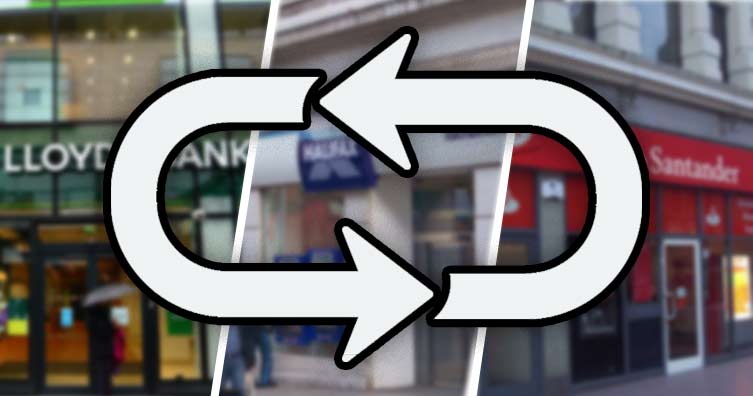How to switch bank accounts
Switching to a new bank account sounds like it could be stressful, so many people never do. But it's much easier than you'd think and it does pay to switch. Here's our step-by-step guide.
Whether you're after the largest overdraft, the best customer service or a reward for switching, it's important to find a current account that works for you. You'll ideally want one that helps you keep control of your finances and hopefully save more money.
But once you've chosen your bank account, how do you actually switch across to it?
Transferring standing orders, Direct Debits, overdrafts and wages might sound like a world of hassle. But, thanks to the Current Account Switch Service (CASS), you barely have to do anything at all. Allow us to explain.
What's in this guide?
Why switch bank accounts?
Here are a few important things to consider before you switch bank accounts:
- Will you get a cheaper or free overdraft?
- How much is the cash reward for switching?
- Are there any monthly charges on the bank account?
- Will you have to pay in a certain amount each month?
- Do you get cashback or other rewards on your spending?
- What is the bank's customer service like?
- Will you be able to accumulate interest on your bank balance?
Switching is nowhere near as stressful as most people think it is. If you're unhappy with your current bank account or think you could get a better deal elsewhere, there's no excuse not to.
6 steps to changing bank accounts
Here is how to switch bank accounts in six simple steps:
-
Choose your new current account
First things first, you need to choose the bank account you want to switch to.
We've ranked and reviewed the best student bank accounts as well as the top graduate accounts on offer.
It's also worth considering one of the customer-friendly digital banks.
Make sure you don't get too distracted by the 'freebies'. Instead, think about the interest-free overdraft, as well as the experiences of other students. These are the things that will affect your day-to-day banking.
After all, an extra £1,000 in your interest- and fee-free overdraft could benefit you more than a one-off £100 voucher.
-
Open a new account
Once you've chosen your bank account, head to the bank website and apply. Specify that you want to switch from another current account when given the option to do so.
To complete your application, you'll need some form of ID and proof of address (your home address, not your term-time one). If you're applying for a student account, you'll also need proof of your student status (usually your UCAS status code or an acceptance letter).
-
Start the bank account switch
Once your application has been accepted and your current account has opened, you'll receive a confirmation email.
You'll then have to fill in forms to trigger the bank account switch: the 'Current Account Switch Agreement' form and the 'Current Account Switch Service – Account Closure' form.
These basically confirm that you're happy to switch from your old current account to your new one, and you're happy for your old bank account to close once the switch is completed.
The Current Account Switch Service is completely free. Keep in mind that if you're new account charges fees, you will need to pay these. But for a lot of accounts, you won't generally need to pay fees, especially if it's a student bank account.
-
Choose your switch date

Credit: Chutima Chaochaiya - Shutterstock
Thanks to the CASS, the switch from your old current account to your new one takes just seven working days.
However, to make things even more convenient, you can choose the exact date that you want the switch to take place. That is, as long as it's not a Saturday, Sunday or Bank Holiday, and is at least seven working days after your new account opens.
This means you can choose a date which will minimise any potential disruption for you. It's best to pick a time that doesn't clash with standing orders at the end/beginning of the month, for example.
Once you've chosen a date, your new bank will have to agree and confirm it. If you want to cancel the switch, you must do so at least seven working days before your switch date.
-
Continue using your old current account as normal
While you wait for your switch date to roll around, you can continue to use your old current account as normal.
But, you shouldn't set up new Direct Debits or standing orders within the seven working days ahead of the switch as these won't be moved to the new account.
-
Everything will move across automatically on your switch date
When the big switch date arrives, you don't have to lift a finger. Your new bank will move all incoming and outgoing payments (such as Direct Debits, standing orders and salary payments) across to your new account, as well as your account balance.
Once they've done that, they'll automatically close your old account for you, and the switch is complete.
This should all happen seamlessly. But if any problems do occur, under the Switch Service guarantee, your new bank will refund any charges incurred as a result of Direct Debits/standing orders not being transferred across.
If you do have any problems with your switch, or you don't think your new bank has abided by the Switch Service Guarantee, you must first complain directly to the bank.
If you're unhappy with their response (or don't receive a response), you can make a complaint to the Financial Ombudsman Service after eight weeks.
Frequently asked questions
These are some of the most commonly asked questions about switching bank accounts:
Can you switch student bank account?

Applications for some student bank accounts are open to first-year students only. In these cases, you won't be able to switch to them once you're in your second, third, etc. year of study.
However, other banks will allow students who aren't first years to switch to their student accounts. Check with the bank first.
Also, remember that student bank account overdrafts often work on a tiered basis. This means you could be eligible for a larger overdraft in your second or third year compared to your first year.
When switching, check what tier you'll be eligible for to ensure you're getting a good deal.
What happens if someone sends money to your old account?
If someone accidentally sends money to your old account, don't panic! The money won't disappear.
For 36 months (three years) after your switch, any payments that get sent to your old account will be automatically redirected to your new account.
The bank will also provide the sender with your new account details, to prevent the same mistake from happening again.
How long does it take to switch bank accounts?
Sitting down and applying to switch your account from one bank to the other takes about five minutes. You simply apply to switch online and hey presto, you're sorted in just a couple of clicks.
That said, it may take a little longer if you're overdrawn, as you might need to get in touch with your current bank regarding repayment arrangements.
The actual process of transferring your cash and Direct Debits (if any) between banks and closing your account takes seven working days.
Can you switch bank accounts online?

Credit: Josep Suria – Shutterstock
Whether or not you can switch bank accounts online depends on whether the bank is signed up for the Current Account Switch Service. You can check if your bank has signed up.
If you're overdrawn, you might not be able to complete the process online. You may need to speak to your current bank and the new bank over the phone or in person to determine your next steps.
Can you switch bank accounts if you're overdrawn?
If you're in your (authorised) overdraft, you'll likely still be able to switch your account as normal, taking your overdraft with you. However, this is not guaranteed.
You'll have to apply for an overdraft with your new bank (student accounts come with a 0% overdraft of varying amounts). How well you've managed your previous overdraft will be taken into consideration.
If your overdraft application is accepted and is equal to/more than the amount you're overdrawn in your old account, you'll be able to transfer your overdraft across.
However, if you're unable to take your overdraft with you, you'll have to make arrangements with your old bank to pay this money back.
Does switching bank accounts affect your credit rating?
Switching to a new current account will only affect your credit rating if you're rejected based on your credit rating, or if you're opening a number of new accounts in a short space of time.
When opening a new bank account, and specifically applying for an overdraft, banks will conduct a credit check. This will leave a footprint on your credit file.
This is perfectly normal and won't have a negative impact on your credit rating, but it's not a great idea to be opening a new bank account every month.
Does your old bank account close after switching?
If you want to open a new current account, but also keep hold of your old account, you can do so. However, you won't be able to use the Current Account Switch Service.
Under the Partial Switch Service, you can get some or all of your payments automatically transferred to your new account. Keep in mind that there's no seven-day guarantee, and you won't get a refund if things go wrong.
You also won't be able to specify your preferred switch date, as you can with a full switch.
Plus, many of the freebies banks offer new customers are only for those making a full switch. Make sure you check the small print for bank switching offers to avoid any disappointment.
How often can you switch bank accounts?
Technically, there is no limit to how often you can switch banks. But you should read the terms and conditions before doing so. Some banks require you to stay with them for a certain period of time to qualify for any bonuses or freebies. Keep in mind that with CASS, it can take seven working days for your account to be switched properly.
And, as mentioned above, opening and closing multiple bank accounts in a short period of time can impact your credit file.
Want to stay with your old bank but get a credit card instead? Some credit cards are only for students.









